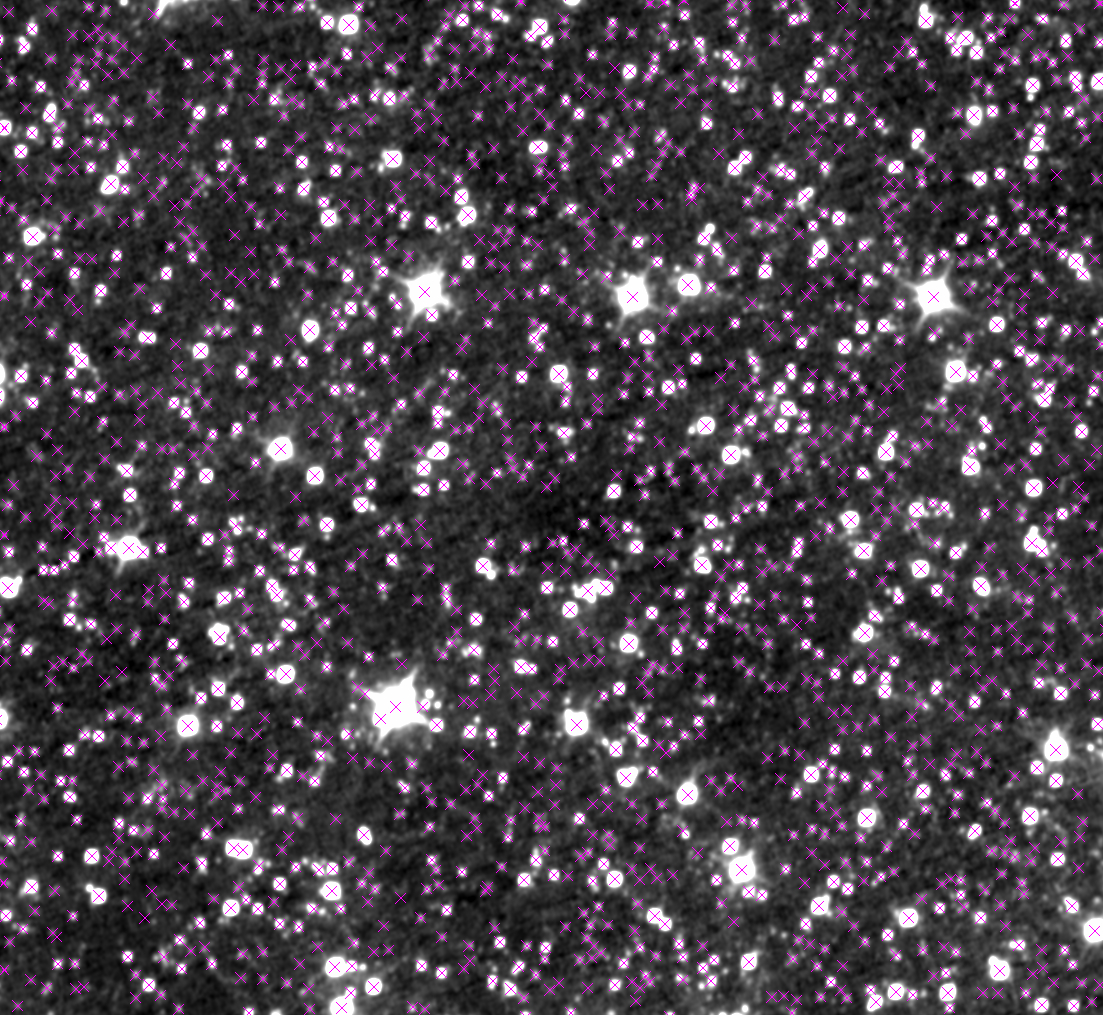

 |
Running SExtractor on WISE Atlas Images |  |
Below we give an example of how to optimally execute SExtractor (Source Extractor) on WISE Atlas Images, making use of the accompanying uncertainty maps. Section II.3.f of the WISE Explanatory Supplement gave an overview of the general formalism for performing aperture photometry (with uncertainty estimation) on an Atlas Image. Here we put some of that methodology into practice. We focus here on aperture photometry although SExtractor also supports PSF-fit photometry. The latter has also been exercised on WISE Atlas Images. We provide an example of "SExtraction" on a WISE Band 1 (W1) Atlas Image of moderately high source density and compare the photometry to that in the WISE All-Sky Source Catalog. The author of this document is no expert on the intricate details of SExtractor, but more information can be found in the User's Manual.
An example SExtractor command-line (i.e., what one would type at the Unix prompt or in a script) is shown below. The primary inputs are a WISE intensity image: 1344m122_ab41-w1-int-3.fits, accompanying uncertainty map: 1344m122_ab41-w1-unc-3.fits, configuration files, and processing parameters. Some of the parameters are described below. These parameters have been optimized to run on a WISE Atlas Image and much experimentation was involved in getting these right.
sex 1344m122_ab41-w1-int-3.fits -PARAMETERS_NAME sex_outcols.txt \
-FILTER_NAME gauss_5.0_9x9_conv.txt -STARNNW_NAME default_nnw.txt \
-c wisesex_params.txt -MAG_ZEROPOINT 20.5 -SATUR_LEVEL 2500 \
-DETECT_THRESH 2 -GAIN 1.0e+20 -WEIGHT_GAIN N,N \
-WEIGHT_TYPE MAP_RMS,MAP_RMS -WEIGHT_IMAGE 1344m122_ab41-w1-unc-3.fits \
-CATALOG_NAME 1344m122_ab41-w1-sex-cat.txt \
-CHECKIMAGE_TYPE -OBJECTS,BACKGROUND \
-CHECKIMAGE_NAME obj.fits,bck.fits -DEBLEND_NTHRESH 32 \
-DEBLEND_MINCONT 0.0001 -BACK_SIZE 130
Notes:
SExtractor does not have an option to specifically apply a curve-of-growth correction to the output aperture magnitudes (listed in 1344m122_ab41-w1-sex-cat.txt). In the above example, we used a fixed measurement aperture of 6 co-add pixels (where 1 co-add pixel = 1.375 arcsec), specified by the diameter parameter "PHOT_APERTURES 12" in the input configuration file (-c wisesex_params.txt). Luckily for WISE, a radius of 6 pixels is also the standard aperture size used for Atlas Image photometry reported in the WISE Source Catalog. The band-dependent aperture corrections using this aperture size are given in Table 4 of section IV.4.c in the Explanatory Supplement. The appropriate value from this table was subtracted from the SExtractor measurements.
For other apertures sizes, this correction will need to be estimated yourself, e.g., from a series of concentric apertures on a bright isolated star. The "PHOT_APERTURES 12" parameter in wisesex_params.txt allows one to specify any number (N) of aperture sizes. These will also need to be listed in the output column specification file: -PARAMETERS_NAME sex_outcols.txt as MAG_APER(1), MAG_APER(2),... MAG_APER(N).
Furthermore, one also has the liberty of filtering on any column in the SExtractor output (1344m122_ab41-w1-sex-cat.txt). One column where you might want to do this is the FLAGS column. For example, to select measurements that are "perfect", retain rows with FLAGS = 0; for measurements with no saturated pixels, avoid rows that encode FLAGS = 4 (in the "bitwise" sense). All flags are defined in the User's Manual.
The Atlas Image uncertainty maps encode all information about the underlying gain (which controls the level of Poisson noise and zero-point scaling) and also the frame depth-of-coverage (effective exposure time). Thus, all the dirty bookkeeping has been done for you. This obviates the need to fiddle with effective gain and exposure-time maps for the SExtractor input.
A detail that SExtractor does not account for is spatially correlated noise in the input image (here the Atlas Image intensity map). The Atlas Image uncertainty maps represent pixel uncertainties in the smoothed (PSF-match-filtered) intensity map, i.e., where the noise is spatially correlated. These uncertainty maps can still be used in SExtractor as above, but the output photometric (flux) uncertainties from SExtractor need to be manually rescaled using the correlation-correction factors plotted in Figures 1 - 4 and described in section II.3.f.i of the Explanatory Supplement.
For example, the run above used a 6 pixel aperture radius. Figure 1 (for W1) indicates a correction factor of ~30 in variance space, or a factor of √30 ~ 5.5 in terms of sigma for this aperture radius. The "raw" photometric uncertainties from SExtractor corresponding to these aperture magnitudes is given by the MAGERR_APER column in 1344m122_ab41-w1-sex-cat.txt. These estimates will need to be multiplied by 5.5 to obtain the correct 1-sigma uncertainties, otherwise they will represent underestimates to the true uncertainty.
The general formalism for correcting correlated pixel-noise when other uncertainty components are present (e.g., confusion noise and/or errors in the zero-point calibration) is summarized by Equations 2 and 3 in section II.3.f (see also text therein). Other components contributing to the photometric error must be RSS'd after the appropriate correction factor (Fcorr) from Figures 1 - 4 is applied to the pixel-noise variance estimate alone.
Following the aperture and correlated-noise corrections described in Sections 3 and 4, we matched the extractions in 1344m122_ab41-w1-sex-cat.txt with those from the WISE Source Catalog using a 1.5 arcsec radius. Furthermore, we only retained WISE Catalog entries satisfying w1snr > 3; w1sigmpro .ne. 'null' (to avoid upper limits); and a reduced chi-square from profile fitting satisfying 0.7 < w1rchi2 < 2. The last criterion ensured predominately point sources with uncertainty estimates that were more-or-less in the right ballpark, i.e., giving reduced χ2 ~ 1.
Figure 1 shows a zoom-in of the W1 Atlas Image tile used for the photometric validation. Overlayed are the objects detected and measured by SExtractor using the example run in Section 1. Figure 2 compares the SExtractor aperture photometry to two flavors of photometry from the WISE Catalog: (i) aperture photometry (w1mag) using the same aperture radius (6 pixels), and (ii) PSF-fitting (w1mpro). The WISE measurements are overall consistent with those from SExtractor except for a growing bias in w1mpro towards faint magnitudes. This is due to the anomaly mentioned in section I.4.b.iv of the WISE Catalog Cautionary Notes. The presence of confusion (which is particularly strong for this field) has the effect of increasing the scatter at the faint end.
The right-most panel in Figure 2 compares the
photometric uncertainty in PSF-fit photometry from the WISE Catalog
(w1sigmpro) to that from SExtractor (MAGERR_APER values corrected
for correlated pixel-noise).
The uncertainties track each other nicely for
w1sigmpro >~ 0.05 (signal-to-noise ratio <~ 22), but deviate at
higher signal-to-noise ratios. This is because the WISE Catalog
uncertainties (w1sigmpro) also include
a contribution from PSF-estimation error.
This contribution is greater for brighter fluxes.
 |
| Figure 1 - Zoom-in on W1 Atlas Image tile 1344m122 with SExtracted sources overlayed (magenta crosses). Field is ~0.42° on a side and centered at l, b ~ 239.69°, 21.08° [Click to enlarge]. |